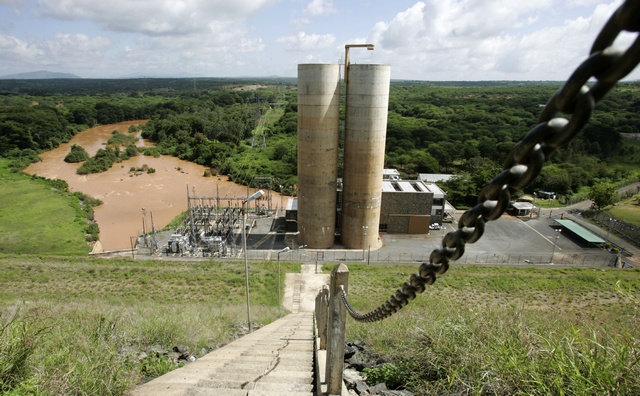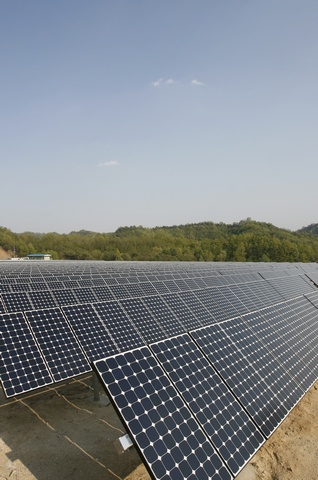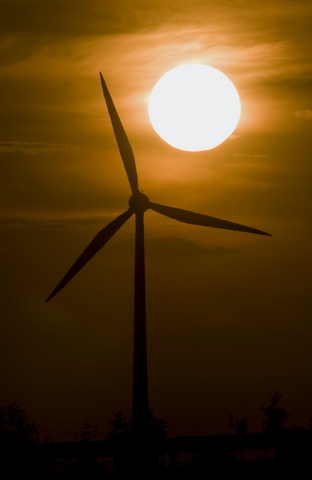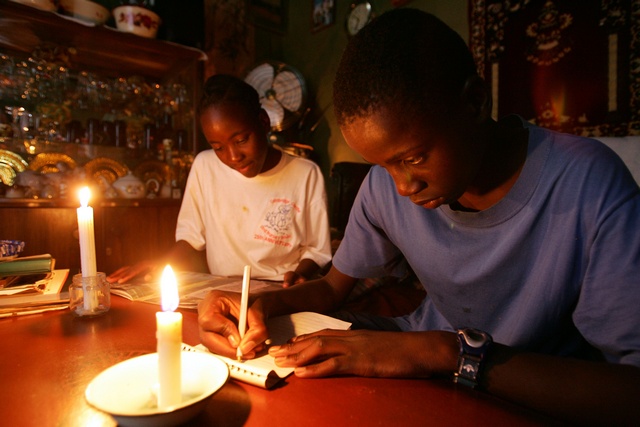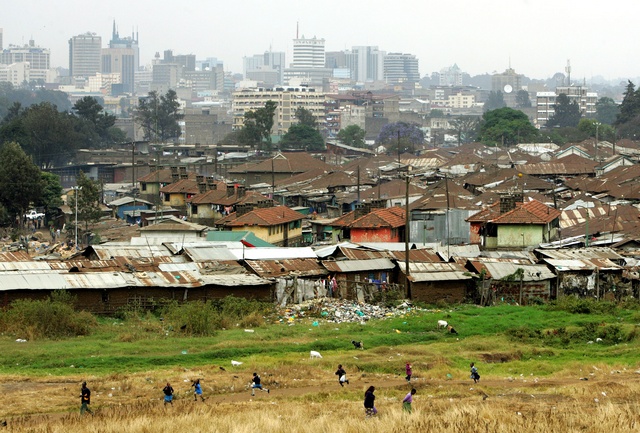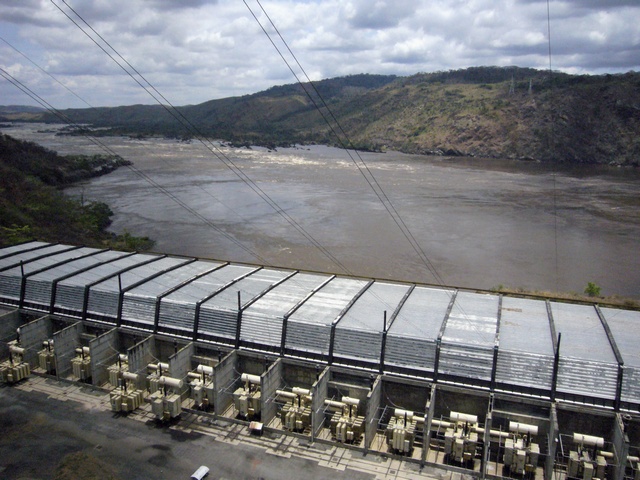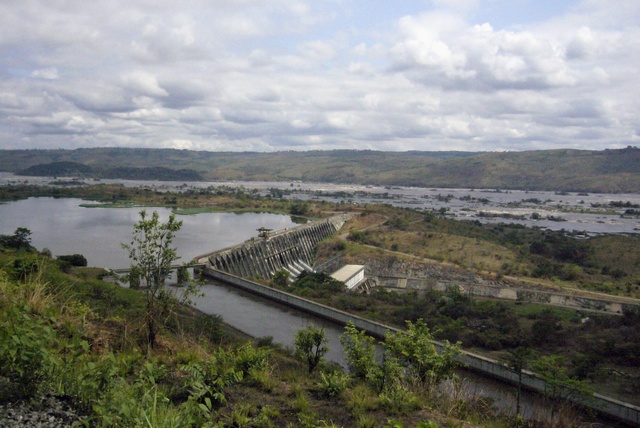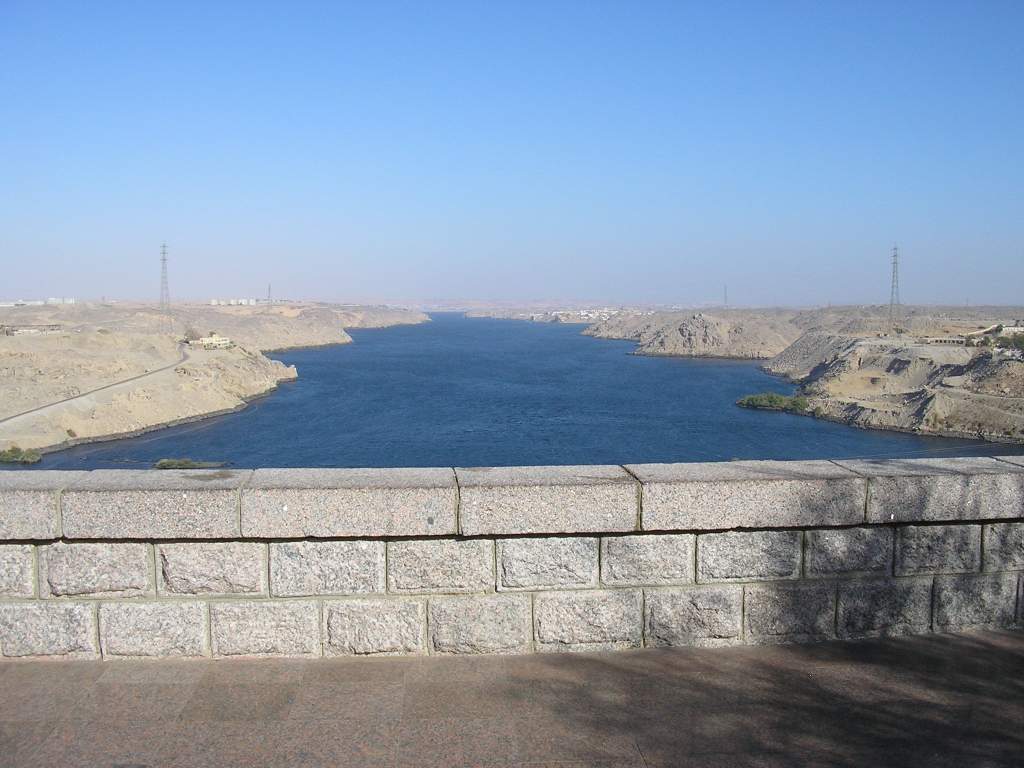|
Electricity in Africa |
|
T H E D A R K C O N T I N E N T A N D E L E C T R I C I T Y I N A F R I C A
Fourteen-year-old Zimbabwean twins Gugulettu (L) and Ntokozo Ndebele read and write by candlelight at their family home in the capital Harare February 19, 2006. Frequent electricity failures and load shedding plague the country and are the result of ageing generating and distribution equipment and a critical shortage of foreign currency to import the necessary spare parts. Zimbabwe does not produce sufficient electricity for its own needs so it imports power from neighboring South Africa, Mozambique, Zambia and the Democratic Republic of Congo (DRC). REUTERS/Howard Burditt
Children play on the way home after school in Pumwani slums near Kenya's capital Nairobi, seen in the background, September 14, 2006. Like other slums in Kenya, Pumwani lack electricity, people pay for water by the bucket and use over-flowing holes for toilets. REUTERS/Antony Njuguna (KENYA)
The dark continent - Electricity in Africa The Economist August 18, 2007
An African energy crisis
Power shortages have become one of the biggest brakes on development SEEN from space, Africa at night is unlit—as dark as all-but empty Siberia. With nearly 1 billion people, Africa accounts for over a sixth of the world's population, but generates only 4% of global electricity. Three-quarters of that is used by South Africa, Egypt and the other countries along the north African littoral.
The need for more power stations in the rest of the continent has long been recognised, but most of the attempts at electrification in the 1970s and the 1980s failed. In some countries, dictators pillaged power stations for parts and fuel. In others, power stations were built but not maintained. Turbines were run at full capacity until they broke, then were abandoned. By some counts, only 17 of Nigeria's 79 power stations, many dating from this period, are still working; the country's demand for power is an estimated 7,600 megawatts, against an actual operating capacity of 3,500MW. The World Bank reckons that 500m sub-Saharan Africans are without what it calls “modern energy”.
The situation is bound to get worse as the demand for power continues to grow. Africa's relatively healthy economic growth of recent years begets factories and shopping centres—and power cuts galore. Whenever demand outstrips supply, the lights go out—several times during the writing of this story. The ubiquitous exodus from huts to houses only adds to the strains. Even the poorest rural migrants, once in the city, prize electric lighting and television sets, and millions are leaving their villages. Kenya's power utility estimates that it adds 12,000 households a month to the national grid.
For now, the continent remains largely dependent on hydropower: 13 countries use it for 60% or more of their energy. But Africa's rain falls more variably than, say, Norway's, and its dams often operate below capacity. Still, many new dams are being planned. Ethiopia has staked its development on damming the Blue Nile and other rivers. In west Africa dams are due to be built on the Niger, the Volta and Bandama. Some of these projects will be held up by financial and environmental disputes, just as Uganda's 250MW Bujagali dam on the White Nile has been. But most will get built.
The river with the biggest hydro potential is the Congo. The potential demand, too, is huge. Only 6% of Congolese have access to electricity and more power will be needed to get at the country's trove of minerals. A grand project to build a series of dams along the Congo's fast-flowing stretches could theoretically supply 39,000MW, enough to power the entire continent. But that will probably remain a dream. Congo has a terrible reputation among investors, and distributing the electricity across thousands of kilometres, much of it jungle, would pose formidable problems.
Aggreko, a company based in Scotland, is the world's biggest supplier of temporary electricity in the shape of back-up generators. It meets up to 50% of Uganda's power needs, and 10% of those of Kenya and Tanzania. It believes that the global power shortfall in the next decade will be much greater than predicted, perhaps over 500,000MW. The ensuing competition for energy, it argues, will see the world split between those countries whose economies grow faster than their power consumption and those, including most of Africa, whose power consumption grows faster than their economies.
Many African governments are looking at alternative sources of energy to make up their projected shortfalls. Hydropower is clean, from the point of view of greenhouse-gas emissions, but most of the easy alternatives, notably coal, are dirty. Donors committed to cutting global carbon emissions are unlikely to favour more dirty coal-fired power stations of the sort that predominate in South Africa, although the government there claims that it wants to clean them up. Some fossil fuels, however, are less damaging than coal. A pipeline planned for west Africa, which will carry gas that is now flared off in oilfields, could stabilise electricity supply in coastal cities.
Few Africans in rural areas have access to electricity. Connecting them to national grids will be slow and expensive. Yet Lilliputian windmills, water mills, solar panels and biomass furnaces could have a big collective impact. The cost of lighting a shack takes 10% of income in the poorest households and the kerosene lamps are highly polluting. In response, the World Bank has rolled out “Lighting Africa”, an ambitious effort to get 250m of the poorest Africans on clean-energy lighting by 2030.
Talk of the mass production of biofuels in Africa is premature, but advances have been made. Some investors are backing jatropha, a plant whose seeds produce an oil for burning in generators. There is also an effort to tap geothermal energy. The Great Rift Valley, from Eritrea to Mozambique, could produce 7,000MW.
Kenya hopes to get 20% of its energy from geothermal sources by 2017.
Engineers think they can also use the steady winds in Africa's mountain ranges for power production. And if the costs of using the sun's warmth can be reduced to 30% below its present cost, vast solar farms could offer cheap, clean energy for African cities and in doing so boost incomes in rural areas. Egypt, which relies mostly on natural gas, is looking hard at solar power.
Other remedies for Africa's power shortages are more familiar but just as urgent: more efficient appliances, such as LED lighting, more deregulation, better use of existing resources by, for instance, improving the quality of power lines, and pooling power into regional grids. Otherwise Africa will remain in the dark.
© The Economist Newspaper Limited, London 2007. All rights reserved
Unlocking African hydro potential. International Water Power and Dam Construction August 14, 2007
IWP&DC has reported on various potential African hydro schemes over the past few years. In this news insight, Neil Ford investigates which schemes are likely to be developed and looks at the major trends in hydro sector development on the continent.
Africa's massive hydroelectric resources have long been recognised but remain relatively undeveloped. A lack of investment, unstable political and investment environments and the limited size of local markets have all deterred the construction of most proposed hydro schemes on the Nile, Congo, Zambezi and other major African rivers over the past 30 years. Yet there are signs that more of the continent's potential is about to be realised. The World Bank's recent decision to back the Bujagali project in Uganda and the spate of new hydro developments in Ethiopia highlight the fact that the lure of export markets enabled by greater power sector integration is likely to drive hydro development over the next decade.
It is easy to downplay the role of hydro schemes within the Pan-African power sector. Hydroelectric plants account for just 23,000MW of the 115,000MW of total generating capacity that is installed on the continent. At about 20% of the total, it could be difficult to argue that Africa is hydro dependent. Yet the lion's share of existing power generating capacity is concentrated at the geographical extremes of the continent: in South Africa, where more than 90% of all electricity is produced by coal fired plants; and in North Africa, where oil fired facilities are all being converted to run on gas, but where there has been relatively little hydro development.
The 45 countries that are sandwiched in between possess less total generating capacity than South Africa and the five Mediterranean African states combined. They are mostly overwhelmingly dependent on hydro schemes that were developed during the colonial era or shortly afterwards, backed up by small scale diesel and oil fired plants that are expensive to run. Another legacy of the colonial period has been that the transmission networks of each state are often isolated from those of neighbouring countries. Since independence, most national power companies have struggled to maintain power supplies to the main towns and little progress has been made on extending power grids, never mind on developing cross-border transmission interconnectors.
During the regular dry seasons or periods of extended drought, reservoir water levels often fall substantially, causing power production to drop and forcing power companies to ration electricity for long periods. However, it would be wrong to characterise the dominance of hydro within this region as a cause of the underdevelopment, economic stagnation and poverty, with which the world is all too familiar. Rather, it would be better to depict the hydro sector as one of the region's few power sector strengths.
Yet in order to build on this strength, structural changes are needed to ensure more reliable and plentiful supplies of electricity to African residential and industrial customers. Firstly, some form of diversification of the generation mix could help. Sub-Saharan Africa's main oil powers around the Gulf of Guinea have finally realised the worth of their gas reserves and new gas fired power plants are being developed in the region. Yet many African states do not possess gas reserves and, in any case, it seems a more fundamental change in the perception of power provision is needed to make the most of natural resources of all kinds.
African hydroelectric schemes may be plagued by variable rainfall patterns, but droughts tend to affect various regions, countries and even parts of countries at different times to others. Much improved transmission links would therefore allow countries experiencing power shortages to import electricity from other regions. They can then help to recoup the cost of these imports when hydroelectric power production attains its design level by exporting electricity to neighbouring states.
The advantage of improved transmission infrastructure has now been recognised and regional power pools are emerging. The Southern African Power Pool (SAPP) is the best known and most successful of these, but the East African power pool is also under development; the five North African states have invested in cross-border links; and some progress has even been made on developing the West African Power Pool (WAPP) over the past year. The WAPP has long been planned but a lack of investment had hampered the construction of new interconnectors.
Bujagali at last
It is the emerging East African power pool that will provide a market for much of the electricity produced by the Bujagali hydro scheme on the upper reaches of the Nile in Uganda. A cross-border transmission line has long connected the Ugandan and Kenyan power grids but a new interconnector between the Kenyan capital Nairobi and the northern Tanzanian town of Arusha should give Ugandan hydro schemes the opportunity to provide electricity to a market of more than 90 million people within the emerging East African Community (EAC).
Uganda already has two hydroelectric schemes on the stretch of Nile within the country between Lake Victoria and the Sudanese border: the 180MW Nalubaale project, previously called Owen Falls, and the 120MW Kiira dam scheme, which was brought on stream in 1999. The Bujagali project has been planned for an adjacent site for many years but opposition from environmental groups and difficulty in attracting sufficient funding held up development.
However, in April the World Bank completed its programme of 'extensive economic, environmental, and social due diligence' and announced that it would help to finance construction. Judy O'Connor, the organisation's country director for Uganda, commented: 'Uganda's workforce is expected to double over the next 15 years, making the creation of jobs through expanded industry, tourism, and commercial services critical. These sectors are energy intensive and will therefore rely on consistent, affordable, and expanding power supply. Bujagali is an important step towards realising the needed level and quality of supply.'
Industrial Promotion Services (Kenya), which is the industrial development arm of the Aga Khan Fund for Economic Development, has formed a joint venture with Sithe Global Power to develop Bujagali. Known as Bujagali Energy Limited (BEL), the joint venture hopes to complete the US$799M scheme by 2011. A spokesperson for the company said: 'We expect to generate at rates of around six cents per unit of electricity, much lower than the current rates of around 25 cents, even though they are heavily subsidised.'
The World Bank has agreed to provide total financial support of US$360M. This comprises a partial risk guarantee of up to US$115M from the International Development Association for the benefit of the project's commercial lenders; an investment guarantee of up to US$115M from the Multilateral Investment Guarantee Agency, the World Bank's political risk mitigator; and a US$130M loan from the International Finance Corporation to BEL. Other funding includes a US$110M loan from the African Development Bank and US$135M from the European Investment Bank.
In addition, the World Bank will provide a further US$300M to help stabilise power generation until Bujagali is completed and fund an electrification programme. At present, just one Ugandan in 20 has access to electricity at home, one of the lowest rates of the electrification in the world. The downstream sector has already been liberalised but greater generating capacity is required to supply the growing market. It is also hoped that the generating capacity of the Kiira project can be increased to 200MW. Increased exports to Kenya should help to generate valuable revenues for the Ugandan power sector.
Objections to the project have come from tourist orientated businesses in the area, particularly those involved in white water rafting. In addition, a spokesperson for the Ugandan National Association of Professional Environmentalists said: 'The flooding will change all the characteristics of the water body here and it will disrupt the whole eco-system. The micro-climate will change and we don't know what the impact of that will be.' However, BEL insists that the impact will be minimal given that it will employ run-of-river technology.
Ethiopian developments
While Bujagali has captured most of the headlines, much greater hydro capacity is set to be developed in Ethiopia. Hydro schemes already contribute 670MW out of the 713MW of capacity on the national grid but the government has finally succeeded in attracting massive investment in new hydro projects. The 435MW Beles, 420MW Gilgel Gibe II and 300MW Tekeze hydro projects are all being developed by private sector companies but all will supply electricity to the main Inter Connected System (ICS), which is owned and managed by the state owned power company, Ethiopian Electric Power Corporation (EEPCo).
China National Water Resources and Hydropower Engineering Corporation (CWHEC) is developing the Tekeze hydro power project, which is a combined power generation and irrigation venture, under a US$350M deal that was signed in 2000. It is expected to be completed in 2008, a year before the Beles scheme, which is being constructed by Salini Costruttori of Italy. One year later still, in 2010, the Gilgel Gibe II scheme should provide more than enough capacity to satisfy domestic requirements.
However, by far the biggest deal was agreed between EEPCo and Salini last year. The Italian firm secured the contract to develop the Gilgel Gibe III scheme, which will have generating capacity of 1870MW and its completion will require large scale investment in upgrading national and cross-border transmission infrastructure. The project's dam will be one of the highest in Africa, at 240m, creating a reservoir with storage capacity of 14.7Mm3 of water, while the ten turbines are expected to provide electricity from 2013. Claudio Lautizi, managing director of Salini, says that it is the largest hydroelectric project under construction in Africa. He added: 'As the price of oil is getting more expensive, hydro power could be the white oil of Ethiopia'. The project, which will be located in the Omo-Gibe Basin in the south-west of the country, will cost a total of US$2B including transmission sector requirements.
EEPCo hopes that this massive step increase in national generating capacity will allow it to greatly improve domestic supplies while at the same time generating export revenues. A new interconnector between Ethiopia and Sudan is currently under development and the national power company plans to target the Sudanese, Kenyan and Djibouti markets. Ethiopia possesses a host of other potential large scale hydro sites and so could become a massive electricity provider to large swathes of Africa that are currently power poor. According to the minister of water resources, Adunga Jebessa, the country has more than 30,000MW of untapped economically feasible hydroelectric potential. The Norwegian government has provided US$7M to help fund feasibility studies into a number of potential ventures, including the 896MW Baro scheme and the 1000-1600MW Karadobi project.
Renewed hope on Inga
While Ethiopia appears to be making headway in developing its hydro resources, progress has been slower on exploiting the country's largest potential hydroelectric resource. The Grand Inga scheme envisages the development of one of the world's biggest hydro schemes on the River Congo in Central Africa. Although the Nile is the longest river, the Congo carries a far larger volume of water, while the Congo Basin benefits from year round rainfall.
A feasibility study on the scheme was carried out by Lahmeyer International and Electricite de France in 1997, which assessed the plan to install 52 turbines with combined generating capacity of 39,500MW, in addition to the existing and planned capacity on the site. It took into account the investment required to construct new transmission lines from Inga to various parts of Africa to market the electricity, and concluded that it was economically and technically viable.
Little progress has been made on making the dream a reality over the past decade, although South African power company Eskom has been keen to become involved in its development and numerous international agencies have cited it as a realistic alternative. This is partly because of the price tag, which will certainly run into the tens of billions of dollars, but also because of the civil war that wracked the host country, the Democratic Republic of Congo (DR Congo), for most of the intervening period.
However, now that the war seems to be at an end, the World Energy Council (WEC) is keen to re-ignite interest in the project. Early this year, the African Development Bank announced US$14M funding for another feasibility study. New transmission lines between Inga and North, West and Southern Africa would have to be constructed. Eskom is particularly interested in becoming involved because DR Congo is part of the SAPP and so Grand Inga could be used as a counterbalance to South Africa's coal fired generating capacity, providing a great deal of stability for the pool.
In a recent report, the WEC argued: 'Given the G8 group of countries' commitment to Africa, WEC believes that it's now time to move from the studies stage to concrete action. The ultimate objective of Grand Inga is to bring affordable and clean energy to the African continent to facilitate economic development to improve the standards of living. It offers a unique opportunity to move the African continent closer to achieving its sustainable development goals.'
The organisation hosted an international forum on 'How to make the Grand Inga hydro power project happen for Africa' in March in Botswana. A plan for the development of the venture was agreed and will be submitted to members of the G8 to gauge international backing. Support for large scale infrastructure projects in Africa has generally fallen over the past decade, as development agencies and domestic and foreign governments have become convinced of the benefits of supporting a much larger number of small scale local development schemes, in the power sector and elsewhere. Grand Inga offers huge potential but likely investors will have to be convinced of the long term stability of DR Congo before they will be prepared to throw their weight behind the development of the ambitious plan.
On a somewhat smaller scale, Canadian firm MagEnergy and South Africa's Industrial Development Corporation are currently undertaking the refurbishment of the Inga II hydro plant. Phase I of the rehabilitation programme, which will be completed by the middle of this year, involved the placement of a rotor on one turbine and the repair of the other three. Work on Phase II, the refurbishment of another four units, will begin later this year. The entire overhaul will cost around US$135M for DR Congo's state power company, Societe Nationale d'Electricite (SNEL). Installed generating capacity at Inga I and II is officially 1700MW but they have been operating at only 700MW for several years because of a lack of maintenance over a long period. The investors will be paid via a revenue sharing agreement with SNEL.
Despite increasing interest in gas fired power plants and renewable energy schemes, investment in hydro projects is rising across the continent. Apart from Inga II, rehabilitation work is taking place on many schemes across Africa, including the 2075MW Cahora Bassa dam in Mozambique, Egypt's 2100MW Aswan dam and Zambia's 600MW Kariba North. Work has now also begun on modernising the 180MW Kpong dam in Ghana, the 180MW Cambambe scheme in Angola and Cameroon's 250MW Edea project. From the Zambezi to West Africa, there are at least a dozen projects across the continent that have gained a great deal of support but where construction work has yet to begin. Much may depend on whether private sector investors are prepared to complement multilateral funding.
As the impact of climate change becomes ever more apparent, in Africa more than anywhere else, it is likely that the recent opposition to new dam construction could give way in the face of a desire to tackle global warming at all costs. By supporting hydro schemes in Africa, foreign governments and companies can claim to be both promoting development in the world's poorer countries and trying to address climate change. Such factors may be just enough to tip the balance in favour of constructing many of the planned hydro projects across the African continent. If the experiences of Uganda and Ethiopia are anything to go by, a new era of African dam construction may be upon us.
© 2007 Wilmington Publishing Limited
Chinese Firm to Invest Sh9 Billion in Solar Power Plant by Kui Kinyanjui August 16, 2007
Aug 16, 2007 (Business Daily/All Africa Global Media) -- A Chinese company has entered into a Sh9 billion partnership with a Kenyan firm to build the first solar panel factory in East Africa.
The move is expected to reposition solar as a key source of energy in Kenya by making it more affordable to millions of consumers who depend on the national electricity grid for their energy needs.
It is estimated that the Beijing Tianpu Xianxing Enterprises and Electrogen Technologies venture could see the prices of solar panels drop by up to 65 per cent.
Manufacture of solar panels is expected to open a lucrative market for scrap metal merchants who have been fighting bruising battles with Chinese experts in the past three years by boosting demand for hydraulic batteries.
Construction of the facility is set to start in October for completion in March 2008. "There is a huge market for solar panels in this market. Currently the near monopoly in the market means consumers pay more than they should. We see prices dropping to a third of what they are currently," said Mr Michael Munyao, the executive director of Electrogen Technologies.
The project will be implemented through Pan African Technologies, a jointly owned company in which Beijing Tianpu has a 70 per cent interest and will raise $100 million (Sh7 billion) from internal resources.
Its local partner is expected take up the remaining fraction of the financing plan in cash and kind, including $40 million (Sh2.8 billion) in cash and three acres of land along Nairobi's Mombasa Road where the factory is to be erected by a local company of Chinese origin.
Once built, the factory will source the materials required locally and employ a minimum of 100 Chinese trained staff.
"Because they will be locally manufactured, Pan-African's products will cost less than the currently available imported options, with a typical system retailing for Sh5,000 rather than Sh20,000," said Mr Munyao.
Pan African is eyeing Sudan as a key market and wants to interest the government in a partnership to provide solar panelling for its planned upgrade of slums in Kibera.
Demand for energy is expected to triple in the next thirty years with alternative energy anticipated to cover the gap. Solar energy is emerging as an investment opportunity globally and its use is projected to grow by 40 per cent for next five years.
Earnings are seen rising from $7.7 billion this year to $11 billion by 2011.
Despite the global interest in solar power, Kenyan firms have seen profit decline due to the high cost of importing foreign products. "This market is highly competitive.
Changing fortunes have seen many firms shut down in the last few years," said Margaret Mutia, the deputy managing director of Solagen, a locally owned solar panel importer.
According to the Ministry of Energy, Kenya receives around 3,000 million free megawatts of power from the sun every day.
Experts says if just 10 per cent of that figure was converted to power on the national grid, the country would be oversupplied with electricity by over 25 times.
Despite its ability to provide 25 times more power to the national grid, solar power is yet to find flavour with Kenyan consumers.
Industry players say the introduction of the government's rural electrification programme is already posing a potential threat to the continued existence of smaller solar energy suppliers.
This year alone, the government will spend Sh8 billion in over 1,000 rural electrification projects around the country, meaning consumers that would normally be targeted by solar power firms now have the option of connecting to the national grid easily.
"Before the programme the sector was confident of continued growth from rural customers because it was so expensive to access electricity and supply was usually inaccessible," said Ms Mutia.
High demand for electricity compelled several foreign solar power firms to invest in the country during the last decade. Now just a handful are still operational, with wary international partners pulling out of the market in the last few months.
In the late 1990s solar power companies could expect to sell 20,000 units in a year, with a comfortable growth rate of 30 per year. Now firms say they are registering drastic reductions in sales, with a 40 per cent drop experienced last year.
Just over 100,000 rural Kenyan families rely on solar energy to generate electricity in their homes. The majority of these families use smaller power units that typically can power one television and four light sources which are sold for over Sh20,000.
The change in fortunes has not been bad for all solar power companies. Chloride Exide is benefitting from a Sh300 million government programme to install solar electricity converters in secondary schools in arid and semi-arid lands in North Eastern, Eastern, Rift Valley and Coast Provinces.
The 44 year old power company has successfully provided power solutions to over 30 schools through the program. "Installation is currently ongoing. The tender was awarded after a competitive bidding process and is sponsored by the Ministry of Energy," said the company in a statement.
Chloride Exide recently shifted from providing batteries to renewable energy solutions, diversification which Solagen believes will save it and other firms from perishing in a shrinking market.
The smaller firms are seeing increased sales of water heating implements to urban consumers who can enjoy savings of up to 60 per cent on power bills.
Around the world, solar power is slowly gaining recognition as a reliable and cheap form of energy. Internet firm Google recently implemented the world's largest corporate solar installation, installing 9,212 solar panels to gain 1,600 kilowatts to power the firms offices.
In the last 24 hours, Google produced 5,286 kilowatt-hours of electricity from the sun, which is enough to run 11,276 hair-dryers at the same time.
© 2007 AllAfrica, All Rights Reserved
An ariel view of the semi-functional Inga dam on the Congo River October 22, 2006. With a flow second only to the Amazon, the mighty Congo river spews forth 1.5 million cubic feet (42.5 million litres) into the Atlantic every second. Experts say it could generate over 40,000 megawatts (MW) of electricity -- more than twice the projected capacity of China 's massive Three Gorges Dam, and a major step to keeping up with fast-growing demand for electricity in Africa and beyond. Picture taken October 22, 2006. TO MATCH FEATURE CONGO-DEMOCRATIC/POWER REUTERS/Marlene Rabaud (DEMOCRATIC REPUBLIC OF CONGO)
An aerial view of the semi-functional Inga dam on the Congo River October 22, 2006. With a flow second only to the Amazon, the mighty Congo river spews forth 1.5 million cubic feet (42.5 million litres) into the Atlantic every second. Experts say it could generate over 40,000 megawatts (MW) of electricity -- more than twice the projected capacity of China 's massive Three Gorges Dam, and a major step to keeping up with fast-growing demand for electricity in Africa and beyond. Picture taken October 22, 2006. TO MATCH FEATURE CONGO-DEMOCRATIC/POWER REUTERS/Marlene Rabaud (DEMOCRATIC REPUBLIC OF CONGO
Aswan Dam, Egypt
|
